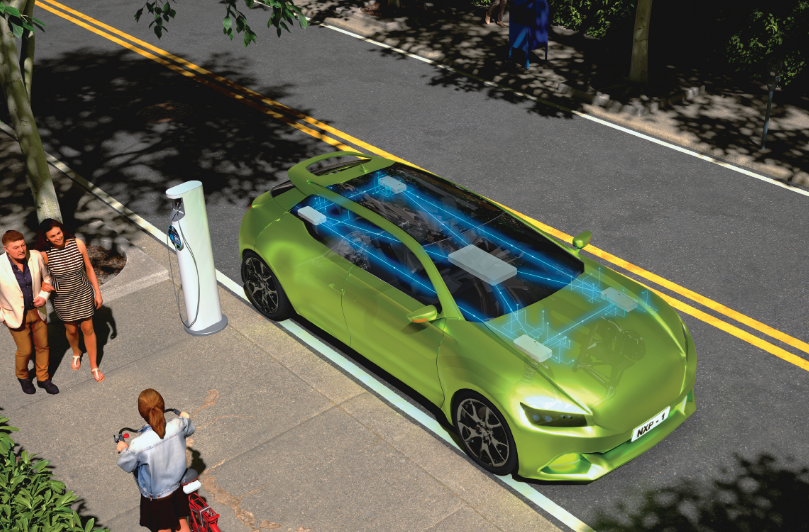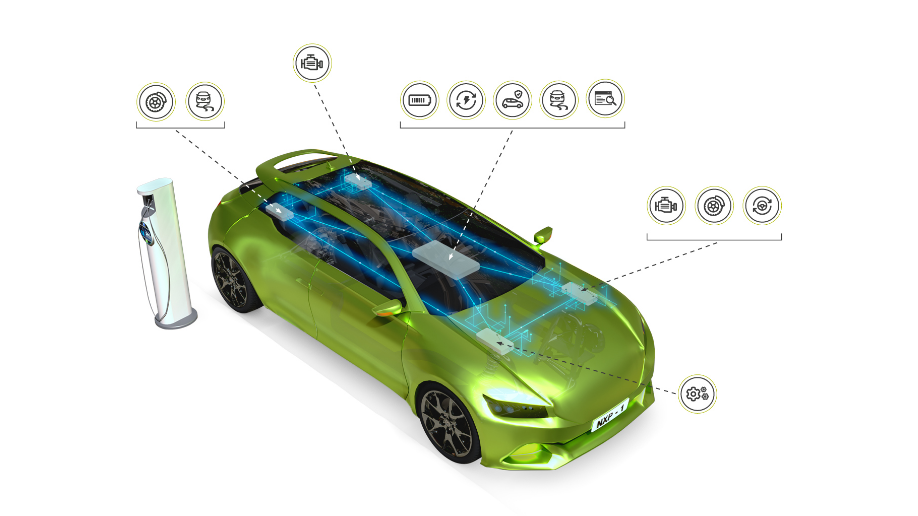NXP launches new S32 automotive platform portfolio S32Z and S32E real-time processor families to enable the next generation of software-defined cars
New class of processors with deterministic safety MCU behavior, offering exceptional Gigabit-class clock speeds, multi-application isolation support, and memory expansion capabilities
Specially designed to provide secure integration of cross-domain functions for software-defined vehicles
Scalable 16nm S32Z and S32E processor families with 5nm solutions planned on the product roadmap
Embedded World, Nuremberg, Germany – June 22, 2022 – NXP Semiconductors NV has announced two new processor families that continue to extend the benefits of the NXP S32 innovative automotive platform with secure, high-performance real-time processing capabilities. The S32Z and S32E processor families help the automotive industry accelerate the integration of multiple real-time applications for domain control, regional control, safety processing and electrification, which are critical to building the next generation of safe and efficient vehicles. The S32Z processor is suitable for safety processing, domain control and regional control, while the S32E processor is suitable for electric vehicle (xEV) control and intelligent driving. The S32Z and S32E processors are software-compatible, helping to realize software-defined vehicles, reduce software integration complexity, and enhance safety.
Major automakers attach importance to the trend of the automotive industry evolving towards domain architecture and regional architecture. They can optimize wiring harness connections, reduce costs and overall weight, and promote the upgrading of smart cars through more scalable, lower-cost, and software-centric solutions. This huge transformation requires new processors that can provide higher performance, isolation between applications, and memory expansion capabilities to support software-defined cars and future innovations.
Deep collaboration across the automotive ecosystem is required to design real-time processors with the performance and deterministic behavior required for the next generation of software-defined cars. Bosch is a key partner in this rigorous process.

“We have worked closely with NXP on the two new processor families,” said Axel Aue, vice president of engineering at Bosch. “The S32Z and S32E processors offer 2x the performance of embedded NVM MCUs. The two new processor families have the key features of an integrated platform with LPDDR4 DRAM and flash memory for scalable storage. The new processor families allow for the integration and isolation of different functions in the car, and they are powerful enough to handle scenarios that previously required multiple microprocessors, making them ideal for embedded integration.”
NXP's S32Z and S32E processors are more comprehensive than existing automotive microcontrollers. The new processor family has eight Arm® Cortex®-R52 processor cores with split lockstep support, operating at frequencies up to 1 GHz, to meet the challenges of safety-integrated deterministic high-performance real-time applications. Through "core-to-pin" hardware virtualization and resource firewalls, the processors isolate independent real-time applications to ensure that they are not interfered with. The processors provide up to 64 MB of integrated Flash memory to enable large-scale over-the-air remote (OTA) upgrades with zero downtime, and support LPDDR4 DRAM and Flash expansion memory in execute-in-place (XiP) mode for large applications and AUTOSAR® adaptive applications. The communication accelerator (FlexLLCE) supporting 24 CAN interfaces and the Gigabit Ethernet switch supporting time-sensitive networking (TSN) seamlessly provide automotive data to "virtual ECUs", thereby improving efficiency and simplifying software development. The hardware security engine (HSE) supports secure boot, accelerated security services and key management. The S32Z and S32E processors are ISO/SAE 21434 certified for cybersecurity and ISO 26262 ASIL D for functional safety.
The S32E processors add intelligent drive capabilities in the form of advanced timers and high-resolution analog-to-digital converters with 5V analog and I/O for xEV integration applications with direct-drive motor control.
The broad versatility and benefits of the S32Z and S32E processors enable leading global OEMs and Tier 1 suppliers to develop new automotive architectures with varying real-time processing performance requirements.
“The new S32Z and S32E processor families strengthen NXP’s leadership in secure, high-performance real-time processing and complement the S32 automotive processor portfolio to support customers’ diverse end-to-end domain control and regional vehicle architectures,” said Ray Cornyn, senior vice president and general manager of automotive control and networking solutions at NXP. “NXP’s real-time processor roadmap is scalable and compatible with planned 5nm technology, enabling customers to design future-proof, fully functional software-defined vehicles.”
S32Z and S32E system support
To accelerate customer designs, NXP provides system support for the S32Z and S32E processors, including the co-developed FS86 ASIL D safety system basis chip (SBC), the PF5030 power management IC (PMIC) with enhanced safety features, in-vehicle network support for Ethernet switches and PHYs and CAN transceivers, and other analog auxiliary chips such as the GD3160 IGBT/SiC high-voltage inverter gate driver and the MC3377x battery cell controller.

Sample acquisition and development support
The S32Z280 and S32E288 are the first two devices to be launched and are currently sampling to key customers. Supported by comprehensive software and tools and a strong partner ecosystem, customers can accelerate chip evaluation, software development and rapid prototyping by using the GreenVIP automotive integration platform software and the GreenBox 3 development platform.
NXP will present a technical paper on “Key Technologies for Enabling Multi-Core Time Domain Controllers” and visit the NXP booth (4A-222) at Embedded World 2022 in Nuremberg to learn about the multi-core performance and fault tolerance of the S32E processor for “Integration of Multifunctional Safety ECUs”.
Previous article:Snapdragon Digital Chassis Helps Ideal L9 Define Flagship Smart Connectivity Experience
Next article:Xpeng and Xiaodu officially announced cooperation to enhance voice interaction experience
Recommended ReadingLatest update time:2024-11-16 14:30






- Car key in the left hand, liveness detection radar in the right hand, UWB is imperative for cars!
- After a decade of rapid development, domestic CIS has entered the market
- Aegis Dagger Battery + Thor EM-i Super Hybrid, Geely New Energy has thrown out two "king bombs"
- A brief discussion on functional safety - fault, error, and failure
- In the smart car 2.0 cycle, these core industry chains are facing major opportunities!
- The United States and Japan are developing new batteries. CATL faces challenges? How should China's new energy battery industry respond?
- Murata launches high-precision 6-axis inertial sensor for automobiles
- Ford patents pre-charge alarm to help save costs and respond to emergencies
- New real-time microcontroller system from Texas Instruments enables smarter processing in automotive and industrial applications
- Innolux's intelligent steer-by-wire solution makes cars smarter and safer
- 8051 MCU - Parity Check
- How to efficiently balance the sensitivity of tactile sensing interfaces
- What should I do if the servo motor shakes? What causes the servo motor to shake quickly?
- 【Brushless Motor】Analysis of three-phase BLDC motor and sharing of two popular development boards
- Midea Industrial Technology's subsidiaries Clou Electronics and Hekang New Energy jointly appeared at the Munich Battery Energy Storage Exhibition and Solar Energy Exhibition
- Guoxin Sichen | Application of ferroelectric memory PB85RS2MC in power battery management, with a capacity of 2M
- Analysis of common faults of frequency converter
- In a head-on competition with Qualcomm, what kind of cockpit products has Intel come up with?
- Dalian Rongke's all-vanadium liquid flow battery energy storage equipment industrialization project has entered the sprint stage before production
- Allegro MicroSystems Introduces Advanced Magnetic and Inductive Position Sensing Solutions at Electronica 2024
- Car key in the left hand, liveness detection radar in the right hand, UWB is imperative for cars!
- After a decade of rapid development, domestic CIS has entered the market
- Aegis Dagger Battery + Thor EM-i Super Hybrid, Geely New Energy has thrown out two "king bombs"
- A brief discussion on functional safety - fault, error, and failure
- In the smart car 2.0 cycle, these core industry chains are facing major opportunities!
- The United States and Japan are developing new batteries. CATL faces challenges? How should China's new energy battery industry respond?
- Murata launches high-precision 6-axis inertial sensor for automobiles
- Ford patents pre-charge alarm to help save costs and respond to emergencies
- New real-time microcontroller system from Texas Instruments enables smarter processing in automotive and industrial applications
- TCP network communication problem
- Using Ginkgo USB-ADC and heart rate sensor to implement a heart rate tester with Android APP source code
- Jump-start your new design with the TI motor control software development kit!
- Signal Chain Design Considerations for Ultrasound Systems
- Analog electronics elective test + DC and AC parameters
- Introduction to TI_DSP link command file (*.cmd)
- The battery output is DC3.0V after LDO. Why does it slowly rise from 0V to 3V when tested with an oscilloscope?
- [New Year's Flavor Competition] + New Year's Eve dinner, visit lanterns, live a wonderful life!
- New metering technology makes every drop of water count
- Introduction to TWS Bluetooth headsets and TI low-power solutions

 NXP Automotive Grade Selection Manual
NXP Automotive Grade Selection Manual Talk about chips
Talk about chips
















 京公网安备 11010802033920号
京公网安备 11010802033920号